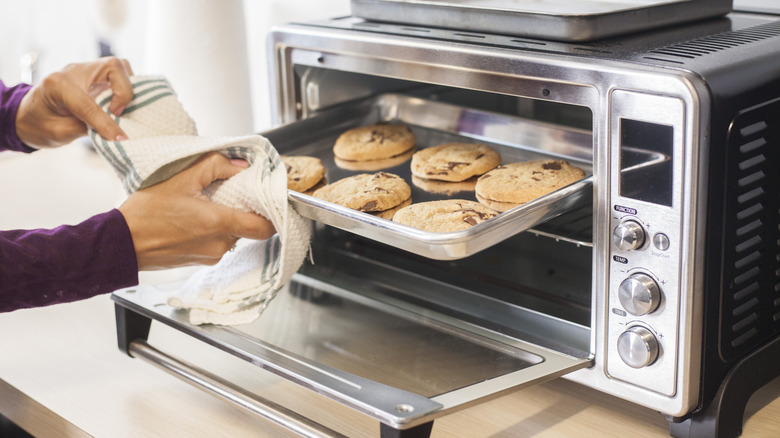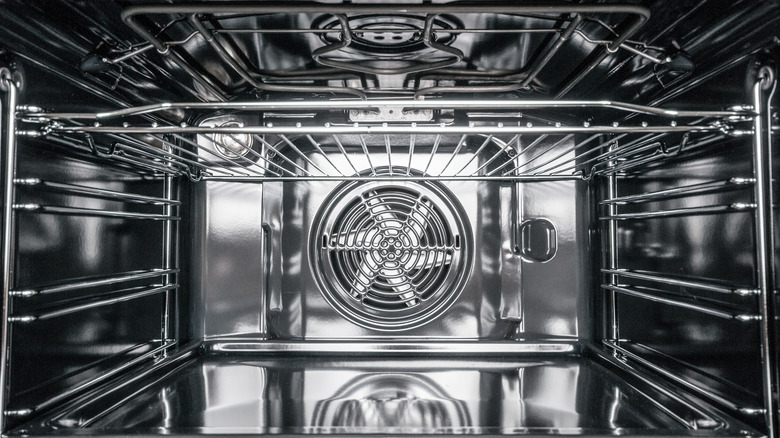What Makes An Air Fryer And Convection Oven Different?
"Air Fryer" is a strange name. It seems to be more of a marketing term than an apt description. As described by Simply Air Fryer, the hot air is moved around the food by fans. That movement helps to transfer the heat quickly and more effectively than still air. It does that so well that it can replicate the golden brown crust we usually associate with something that comes from a deep fryer. Hence, "air fryer."
That name, along with the infomercials that touted fried foods with minimal oil have made this countertop appliance really popular. What was once a cult favorite of folks who wanted food fast has become something closer to a kitchen staple. American air fryer usage soared in recent years. Sales have increased by 76% and exceeded 25 million units in a recent year, per NPD.
A convection oven shares a similar description; hot air is moved by a fan. But, these aren't countertop appliances and never had the benefit of a marketing-friendly name and late-night commercials. And, unlike the air-fryer, which was invented to reheat french fries at home (per The New York Times), convection ovens have had a tough time transitioning from commercial kitchens to our homes despite an almost 50-year head start (per Michigan State University).
So, both are full of hot air (that's moving). What's the difference between air fryers and convection ovens after all?
What's a convection oven?
The Washington Post explains many cooks' confusion about what, exactly, a convection oven does. The advantages of faster cooking come with a steep learning curve as you get to know your oven. Because few home ovens have the fan in the back wall that makes them convection ovens, most recipes are written for standard ovens. That means you need to adjust the oven temperature by about 25 degrees Fahrenheit, and the cooking time by 25%. More confusing is the fact that there are foods that don't benefit from a windy, dry heat, like a Rainbow Layer Cake (will rise unevenly), French Macarons (too delicate), and items with toppings that can just blow away, like New York Style Crumb Cake.
On the plus side, did you hear about the faster cooking time? That speed means it's a more efficient use of energy. For the few things that can't take the wind, most everything else loves that dry heat. Roasted anything will develop a crust that can't be achieved in a standard oven. Because the heat is moving, convection ovens are less likely to have hot or cold spots. There's no need to rotate pans. For the same reason, you can fill these ovens to the brim without extending cooking times or risking poor results.
How an air fryer is better for most homes
The biggest benefit of an air fryer is that the small size means the fans are closer to the heat and on top of the food, per Better Homes & Garden. That configuration focuses that intense heat on a specific, albeit small area. That makes for even better browning at faster speeds. The small size also means that you don't need to preheat for very long, saving you a lot of time. But, that relatively tiny cooking capacity is also the biggest problem with air fryers. They're great for a few people, but if you have more mouths to feed, you'll need to cook in batches.
The air fryer learning curve is almost nil. Air fryers have become ubiquitous so quickly, there's no shortage of resources, recipes, cookbooks, blogs, and social media content letting you know exactly what to put into an air fryer. There's even a trend to start including air fryer instructions on packaging according to Food Manufacture.
As with convection ovens, there are types of foods you should not be making in your air fryer. But there's no doubt an air fryer is a convenient convection option. They deserve consideration in a kitchen. And if you fall in love with those fans, you can always upgrade your full-size oven when it comes time for a replacement.


